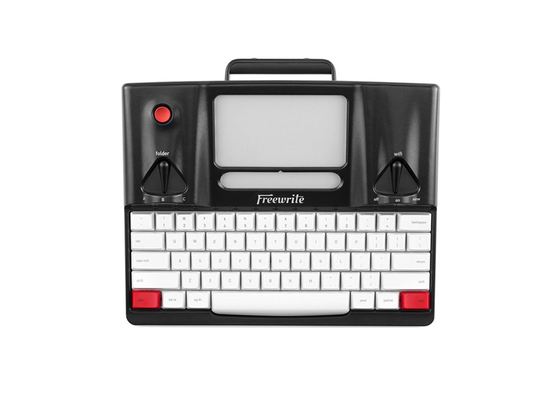
A few years ago my mother sent me a link to a product called the Hemingwrite. It was a distraction-free word processor, or if you like, a modernised typewriter. It had a small screen, a high-quality keyboard, solid aluminium casework, and could do little else beyond accept your words with a series of satisfying clicks from those tactile Cherry keys, and send them via wifi to the cloud. There was no browser, no apps, and it didn’t even have arrow keys. I was fascinated.
I kept a close eye on it through its Kickstarter campaign, its agonising lead up to production, through its rebranding to the Astrohaus Freewrite, right on through to unboxing videos and other reviews online.
While I enjoy reading about technology and playing with it at friends' homes, I’m not an early adopter. I prefer to hang back through the breakages, fires, maimings, and explosions before I commit (not that the Freewrite went though any of those new-product rites of passage). Also holding me back was the $500 (Dh1,836) price tag — it was a lot of money for one-use product in the days of your screens offering five senses and the world. And finally, I didn’t think the Freewrite suited to writing articles, so didn’t want to buy one until I was sure I had a longer story to tell.
“The $500 Freewrite word processor is pretentious hipster nonsense,” went the headline of an article on Mashable.com (Christina Warren and Karissa Bell, February 24, 2016). It was a brutal takedown of the product — neither author understood why anyone would want one when there were so many free distraction-free apps out there, and that it cost the same as a good tablet, but weighed four times as much.
I heard them. I still wanted one. I knew there was something in the weight of this overengineered, under-featured product that would appeal to me in a way that the authors’ suggestion of getting an iPad Air 2, a keyboard, and a distraction-free writing app just wouldn’t.
Perhaps the most controversial feature, or non-feature, of the Freewrite is its lack of editing capability. Many users say it should at least have arrow keys — even if only to go up a couple of sentences and correct typos. I was inclined to agree, especially when writing a shorter article of 600 or 1,200 words, rather than getting through the 100,000 words of a novel.
But as I write the first draft of this very article on the Freewrite, I realise there’s power in that constant forward momentum. Wanting to immediately correct errors is pure ego for me, and it’s an act of rebellion to let those typos sit there until the second draft, like dirty dishes left overnight in the sink. As I plough on, if a paragraph doesn’t work, I leave it in place, and simply start it again. I don’t tweak or tinker, I just move on, filling empty space.
When you roll a sheet of paper into a typewriter and press down on a key, you’re taking an object in this world and forever changing it. There is no easy way to go back from those hammered impressions, and the Freewrite has a sense of this heft and inevitability. You don’t sit down at one of these machines unless you mean it. Conversely, sitting down at one of these machines requires you to mean it.
Does that sound like more “pretentious hipster nonsense”? I’ll know for sure in six months when either my Freewrite is in constant use, or buried in the same dusty drawer as my fountain pen with green ink.
Gautam Raja is a freelance journalist based in Los Angeles, US.












